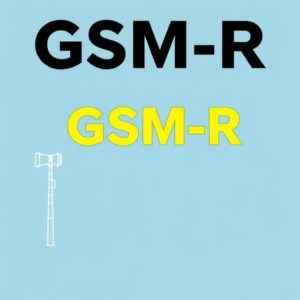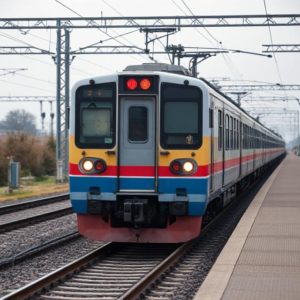GSM-R stands for Global System for Mobile Communications – Railway. It’s a special type of mobile communication system used by railways to help train operators, staff, and control centers communicate with each other in real-time.
In simple terms, GSM-R is like a phone system for trains and railway stations, but it’s designed to be more reliable, safe, and secure for train operations. Let’s break it down and explain it easily:

1. What is GSM-R?
- GSM-R is a type of radio communication system that allows railway operators to stay connected and manage trains. It’s based on the GSM (Global System for Mobile Communications) mobile network, which is used by regular mobile phones, but it’s modified and adapted for the specific needs of railways.
- The system is digital and private, meaning it’s only used by the railway sector, not for public use.
2. Why GSM-R is Needed:
- Railways are big, with trains running over long distances, often in remote areas where regular mobile signals don’t work well. GSM-R helps fill in these gaps by providing reliable communication over a large network.
- It ensures that there’s no communication breakdown between train drivers, control centers, and other railway staff, which is critical for safety and efficiency.
3. How GSM-R Works:
- Communication: GSM-R allows two-way communication between the train driver and the control center, or between different stations. It uses radio waves and dedicated channels for clear and fast communication.
- Emergency Calls: If there’s an emergency or issue on the train or tracks, the driver can instantly contact the control center using GSM-R. This helps them get quick instructions or help.
- Train Information: GSM-R also allows the control center to send important information to the trains, like changes in train schedules, track conditions, or emergency updates.
4. Key Features of GSM-R:
- Voice Communication: It supports clear voice calls between train drivers, station staff, and control rooms, even in areas where regular phone networks might not work.
- Data Transmission: GSM-R also allows for the exchange of data between the train and control centers. This can include things like train speed, location, and other operational data.
- Text Messaging: In addition to voice calls, GSM-R also supports text messaging, which can be used for sending instructions or other important information to train operators.
- Dedicated Frequency: GSM-R uses specific radio frequencies that are not shared with regular mobile phones, meaning it’s less likely to face network congestion during peak times.
- International Compatibility: Since GSM-R follows international standards, it can be used across different countries, allowing trains to communicate even when crossing borders.
5. Components of GSM-R:
- Train Radio (Mobile Station): This is the device on the train that allows the driver to communicate using GSM-R. It’s like a specialized mobile phone for trains.
- Base Stations: These are the towers or stations along the tracks that provide the GSM-R network coverage. They ensure that communication is maintained as the train moves from one station to the next.
- Control Centers (Network Operation Centers): These are the locations where railway operators and control staff manage train movements, monitor communications, and ensure the smooth operation of the railway network.
6. Benefits of GSM-R:
- Safety: GSM-R improves safety by providing constant communication between the train crew and control centers. In case of an emergency, the driver can immediately call for help or relay information.
- Efficiency: It helps improve train operations by allowing real-time updates on train schedules, track conditions, and other information.
- Reliability: Since GSM-R uses dedicated frequencies and infrastructure, it’s more reliable than regular mobile networks, ensuring communication even in challenging environments like tunnels or remote areas.
- Reduced Delays: Faster communication helps reduce delays, manage train schedules, and provide instructions quickly to avoid accidents or operational issues.
- Cross-Border Communication: GSM-R can be used in multiple countries that have the same system, which is helpful for international train travel.
7. GSM-R vs. Regular Mobile Networks:
- Dedicated Network: Unlike regular mobile networks, GSM-R is designed specifically for railway communication. This makes it more secure and reliable than public mobile phones.
- Long-Range Coverage: GSM-R is designed to work over long distances along the tracks, while regular mobile networks may not have good coverage in remote areas or along the railway lines.
- Prioritization: GSM-R communication is prioritized, meaning it gets immediate attention and clear channels for communication, which is crucial in emergency situations.
8. Challenges with GSM-R:
- Infrastructure Costs: Setting up the GSM-R network requires significant investment in base stations, radio systems, and other equipment.
- Upgrading Systems: As technology advances, older GSM-R systems may need to be updated or replaced to keep up with new features or communication needs.
- Maintenance: Like any communication network, GSM-R requires regular maintenance to ensure it remains functional and free of problems.
9. The Future: ERTMS and GSM-R:
- ERTMS (European Rail Traffic Management System) is a broader system that uses GSM-R for communication but also incorporates other advanced technologies for train control and safety.
- GSM-R is an important part of ERTMS, but future upgrades are expected to bring even more advanced features for automation, data sharing, and train management.
Conclusion:
GSM-R is a specialized communication system designed to keep trains, control centers, and staff connected with clear and reliable communication. It improves safety, efficiency, and coordination in railway operations. It’s a vital tool for managing train movements, reducing delays, and handling emergencies, ensuring that railways continue to run smoothly and safely.
Keywords: Indian Railway, Railway











